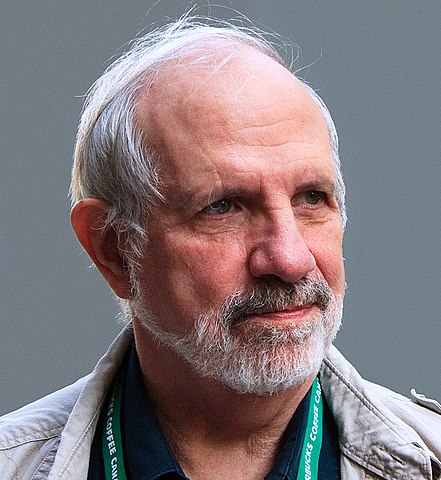De Palma: Photo Attribution: gdcgraphics, CC BY-SA 2.0 https://creativecommons.org/licenses/by-sa/2.0, via Wikimedia Commons
As my readers are well aware, Brian De Palma is one of my favorite directors. In this post, we will look at many of his best neo-noir movies. He made no secret that Hitchcock was his idol and tried his best to emulate him. Besides Hitchcock, De Palma was also influenced by directors Michelangelo Antonioni and Francis Ford Coppola. He was also heavily influenced by legendary Giallo directors like Dario Argento and Mario Bava, incorporating many of their filmmaking techniques.
While it is true that many of his movies have missed the mark and warrant criticism, I also feel that some are masterpieces overlooked by critics and audiences.
Recurring Themes
There are many recurring themes in his movies, many also seen in Hitchcock’s movies. Let’s look at some of them. I have intentionally avoided using examples of De Palma movies in discussing these themes. In my next post, I will discuss some of his neo-noir movies and provide examples of his use of these themes in his movies.
Noir Camera Work
One of the greatest impacts of Film Noir on contemporary directors was innovative lighting to achieve shadowing effects on film. De Palma’s movies, especially the neo-noir ones, borrow and enhance the use of light and dark using classic noir techniques.
Surreal Imagery
One aspect of De Palma’s movies viewers should look for is imagery, whether outdoor scenes or well-designed and constructed sets. These alluring visuals enhance the movie-watching experience. Captivating imagery was part of many Giallo movies, which undoubtedly left an impact on De Palma.
Long Sequences with Background Music and No Dialogue
Sometimes De Palma combines beautiful imagery with background music in a long take, without any dialogue. These scenes effectively set the tone for chills and thrills to appear. The locale could be a museum, a lavish shopping mall, or a majestic opera performance. The camera motion in these scenes is spectacular as it moves alongside the characters.
Blurring the Lines Between Reality, Illusion, Memory, and Imagination
De Palma loves shocking the audience by changing the context of a scene, effectively pulling this off in many of his movies. One recurring theme is the audience’s belief they are watching the plot unfold, only for De Palma to switch the context, revealing the scene to be part of a movie within the movie’s plot.
Another strategy is the character experiencing events that appear real but could either be a hallucination or something staged to deceive them. This sleight of hand is another of his techniques to surprise the viewer. Readers may recall how Hitchcock did this in “Vertigo” and “The Lady Vanishes.”
Look-alikes
Using “Lookalikes” is another recurring theme in his movies, as seen in Hitchcock classics like “Vertigo.” In many De Palma movies, he explores the “Lookalike” theme with siblings, parent-child resemblance, or one character made to look like another.
Brutal Killings
As a fan of Hitchcock and Giallo movies, sadistic murders are ubiquitous in De Palma movies. These characters could be serial killers, disturbed individuals, callous hitmen, or remorseless masterminds. De Palma often tries to recreate the magic of Hitchcock movies like “Psycho,” “Frenzy,” “Rope,” and so on by imitating and improvising on them. Directors like Hitchcock and De Palma seem to understand that while human nature detests or tries to avoid violence, paradoxically, it has a morbid fascination for it.
Voyeurism and Obsession
“You like to look, don’t you?” Both Hitchcock and De Palma were fascinated with the human propensity to be captivated by something visually stimulating. This could appeal to our primal lust or be something out of the ordinary, perhaps a crime in progress, an accident, and so on. Hitchcock used voyeurism in “Vertigo” and “Rear Window.” Often voyeurism manifests as extreme obsession.
Easter Eggs
My definition of an Easter Egg in relation to movies is an allusion, visual, or auditory, that the director strategically places in a movie to prompt the viewer to reminisce about something related to it in another movie. De Palma used many Easter eggs throughout his movies, like slasher scenes referencing Hitchcock’s “Psycho” or strangulation scenes paying homage to “Frenzy,” “Rope,” or Giallo movies. In many movies, he would reference his own movies by placing a stroller in a scene, an obvious allusion to “The Untouchables.”
Controversies
De Palma was unafraid to push the envelope in many of his movies, naturally attracting a lot of criticism. His movies have been labeled by many as misogynistic, feminist, and criticized for depicting excessive violence, gore, and pornography.
Whether one likes him or not, he will always be considered a legendary filmmaker and continue to inspire new moviemakers now and in the future. In my next post, we will look at some of my favorite Brian De Palma neo noir thrillers.
References:
https://en.wikipedia.org/wiki/Brian_De_Palma

